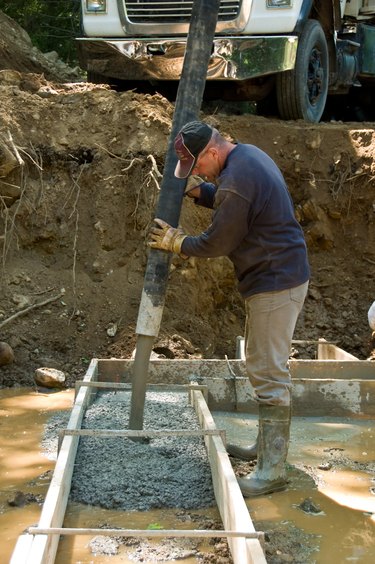
Pouring the footer is the first step in the construction of a new home, right after the excavation. When the heavy equipment operator digs out the hole for the basement, she will also dig trenches about 1 foot deep and 2 feet wide for the footers. Check with your local building authority because additional regulations might apply in your community. Footers serve as structural bases on which the weight load of your house rests. They offer more support than concrete foundation walls alone can provide. Footing depth for crawl space foundations is determined by the frost line in your community.
Where
Video of the Day
You should pour a footer under every load-bearing wall. This means that all the exterior foundation or basement walls need footers and, in addition, any interior load-bearing wall will need a footer. Load bearing walls are indicated on your home plan blueprints.
Video of the Day
Virgin Soil
Building codes regulating soil condition vary, usually dependent upon the type of soil that is predominant in a community. Check with your local building authority before pouring the footers. The general rule is to pour footers on virgin soil or compacted soil, but there are exceptions. Virgin soil is preferable because it has settled naturally over many years. Once you disturb the soil, it will settle and shift as backfilled soil filters into voids. For this reason, some footers do not have forms but are poured directly into precision-dug trenches to reduce voids. If the trenches are wider than necessary, you'll have to form the footers to contain the concrete.
Compacted Soil
If you're pouring a basement on soil that's been disturbed, such as a recently landscaped development, your local building authority may require compaction tests. However, if the soil is high in clay, compaction can result in foundation problems later. Heavy clay soil, once compacted, has something akin to a memory, and if it becomes saturated, it can swell, causing your basement floor to heave upward. Consider soil testing if you're unsure about the soil content.
How
Before you call the concrete truck, you'll have to reinforce the footer trenches or forms. Local building codes may differ slightly, but standard steel reinforcement calls for running three rows of long rebar, evenly spaced, in each footer trench. Local code may also require cross sections of rebar. In either case, you must raise the level of the rebar until it rests in the middle of the footer. You can do this by positioning the steel bars on rebar chairs to elevate them. After you pour the concrete, while it's still wet, you'll insert vertical rebar into the footers. When you pour the concrete walls, these vertical bars tie the footers securely to the basement walls.